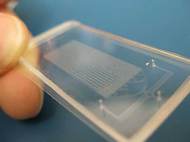New biosensors arise from glowing bacteria synchronization research
 Biologists and bioengineers at UC San Diego have created a living neon sign composed of millions of bacterial cells that periodically fluoresce in harmony like blinking light bulbs. By utilizing the same method they used to create the flashing signs, the researchers managed to make a simple bacterial sensor that could be used to detect many kinds of environmental pollutants at low costs.
Biologists and bioengineers at UC San Diego have created a living neon sign composed of millions of bacterial cells that periodically fluoresce in harmony like blinking light bulbs. By utilizing the same method they used to create the flashing signs, the researchers managed to make a simple bacterial sensor that could be used to detect many kinds of environmental pollutants at low costs.
“Many bacteria species are known to communicate by a mechanism known as quorum sensing, that is, relaying between them small molecules to trigger and coordinate various behaviors”, said Jeff Hasty, a professor of biology and bioengineering at UC San Diego who headed the research team in the university’s Division of Biological Sciences and Biocircuits Institute. “Other bacteria are known to disrupt this communication mechanism by degrading these relay molecules.”
The success of UC San Diego researchers relies on nearly four years of research where they first managed to develop a way to construct a robust and tunable biological clock to produce E. coli bacteria that glows when desired, and afterwards create a network that is based on a bacteria communication mechanism which is used to synchronize all of the biological clocks within a bacterial colony. However, their findings couldn’t enable them to coordinate thousands of colonies to glow at desired time.
The problem for a much larger scale takes place due to the signal propagation time, since it takes a while to synchronize 60 million other cells via quorum sensing. However, graduate students Arthur Prindle, Phillip Samayoa and Ivan Razinkov, designed a microfluidic chip which is used emit a signaling gas used to synchronize the colonies, and the bacteria within separate colonies are synchronized via quorum sensing.
Each of the blinking bacterial colonies consist of what the researchers refer to as a biopixel – an individual point of light much like the pixels on display devices – and the researchers managed to create larger microfluidic chips capable to control about 13,000 colonies (or biopixels), as well as simpler and smaller chips that control about 500 biopixels.
Due to the ability of bacteria to sense many kinds of environmental pollutants and organisms, the scientists believe they could use their research in order to design low cost bacterial biosensors capable of detecting an array of heavy metal pollutants and disease-causing organisms. Since the sensor would consist of living organisms, it could be used to measure the quantity of nearby toxins over time, a feature many chemical sensors can’t accomplish.
“These kinds of living sensors are intriguing as they can serve to continuously monitor a given sample over long periods of time, whereas most detection kits are used for a one-time measurement”, said Hasty. “Because the bacteria respond in different ways to different concentrations by varying the frequency of their blinking pattern, they can provide a continual update on how dangerous a toxin or pathogen is at any one time.”
UC San Diego researchers believe they will be able to develop a small hand-held sensor that would rely on the fluctuation of signals generated by bacteria colonies. These signals would be concentrated by disposable microfluidic chips in order to determine the presence and concentrations of various toxic substances and disease-causing organisms in the vicinity of the sensor.
For more information, read the paper published in the journal Nature named: “A sensing array of radically coupled genetic ‘biopixels’”.









Solar power is neat we should get all our power from the sun, the world would be a much greener and happier place.